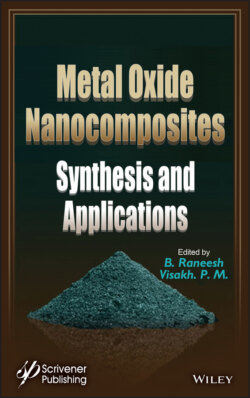Читать книгу Metal Oxide Nanocomposites - Группа авторов - Страница 10
Оглавление
Preface
Recently, there have been a number of research accomplishments in the field of metal oxide nanocomposites and their synthesis and applications, many of which are summarized in this book. Besides discussing the state of the art in the field, new challenges and opportunities regarding their use are also presented. Along with the structure-property relationships of metal oxide nanocomposites, the book also includes introductory material on nanocomposites, graphene-based metal and metal oxide nanocomposites, carbon nanotube–metal oxide nanocomposites, and metal oxide-based nanocomposites. In addition to the application of metal oxide nanocomposites in photocatalysis and sensors, among the other topics presented are thermal analysis of the properties of metal oxide nanocomposites, semiconducting metal oxides for photocatalytic and gas-sensing applications, applications of metal oxide-based nanocomposites, triboelectric nanogenerators (TENG) based on nanocomposites, and metal oxide nanocomposites for water purification. Since this book is an up-to-date record of the major findings and observations in the field—with chapters contributed by prominent researchers from industry, academia and government/private research laboratories across the world—it will act as a very valuable reference source for university and college faculties, professionals, post-doctoral research fellows, senior graduate students, and researchers from R&D laboratories working in the area of metal oxide nanocomposites.
The introductory chapter discusses the scope, state of the art, preparation methods, new challenges and opportunities concerning metal oxide nanocomposites. Chapter 2 gives a more detailed review of structure-property relationships. Included in the many topics discussed in this chapter are the functions of fibers and matrix, classification of composites, matrix-based composites, reinforcements, polymer composites, composites processing, product fabrication, application, and special features of composites, along with their advantages and disadvantages compared with metals.
Graphene-based metal and metal oxide nanocomposites are introduced in Chapter 3. In this chapter, the authors discuss graphene, reduced graphene oxide, graphene-based composites and hybrid nanocomposites, mechanics of graphene nanocomposites, covalent and noncovalent functionalization and thermal properties. Chapter 4 on carbon nanotube–metal oxide nanocomposites introduces carbon nanotubes, including packaging applications, followed by different topics such as synthesis methods, environmental applications, environmental fate, transport, transformation, and environmental implications; and concludes with the direction that future research might take.
Two main topics are addressed in Chapter 5. The first is nanocomposite photocatalysts based on metal oxide, including those based on TiO2, ZnO and WOx. The second topic, the application of metal oxide composites in photocatalysis, includes a discussion of water splitting for hydrogen generation, photodegradation of pollutants and wettability patterning based on photocatalysts. Chapter 6 is a structural analysis of metal oxide nanocomposites for sensor applications. Following an introduction to the subject matter, the chapter goes on to discuss binding of metal oxide with imidazole and silane, characterizations, absorption and emission characteristics, and sensing mechanisms.
Thermal property analysis of metal oxide nanocomposites is discussed in Chapter 7. In this chapter the authors explain the use of metal and metal oxide nanoparticles in thermal management and synthesis procedures, the mechanism of thermal conductivity enhancement and thermal conductivity modeling of nanofluids. In Chapter 8 there is a two-part discussion on the topic of semiconducting metal oxides for photocatalytic and gassensing applications. The first part covers topics such as organic dyes as a major source of water pollution, conventional methods used for dye degradation, advanced oxidation processes, the role electronic structure of semiconducting metal oxide plays in photocatalysis, basic principles of photocatalysis, oxidizing species generation mechanism, semiconductor photocatalysts, kinetic studies of semiconductor photocatalysis and parameters affecting dye degradation. The second part of the chapter covers topics such as the evolution of gas sensors and their necessity, metal oxides as gas sensors, the gas-sensing mechanism of metal oxides and factors influencing sensor performance.
Metal oxide-based nanocomposites and their many applications are the subject of Chapter 9. It covers their use in the food and agricultural sector and in medicine due to their water barrier, thermal and flame-retardant properties, and their ability to disinfect water and improve water flux. Also discussed are nanocomposite membrane assemblies for water treatment prepared by non-solvent induced phase separation method, their adsorption performances, and their suitability for electrocatalytic, biosensor and sensing applications. Next, in Chapter 10, energy harvesting and sensing applications of triboelectric nanogenerators (TENG) are presented. Among the topics discussed are the working mechanism of a triboelectric nanogenerator, how to select materials for your TENG, basic operating modes of TENG, TENG as mechanical energy harvester, and TENG based on vertical contact separation mode, lateral sliding mode, single electrode mode and free-standing triboelectric layer mode. The final chapter on metal oxide nanocomposites for water purification includes several topics such as adsorptive removal of water pollutants; and the use of metal oxide nanocomposites for photocatalytic decomposition of water pollutants, removal and decomposition of inorganic pollutants, and decomposition of organic pollutants.
In conclusion, we would like to express our sincere gratitude to all the contributors to this book, whose commitment and sincerity shown towards their contributions, along with their enthusiasm and excellent support, enabled the successful completion of this venture. We would also like to thank all the reviewers who have taken their valuable time to make critical comments on each chapter. Finally, our thanks go out to Scrivener Publishing for recognizing the demand for such a book and realizing the increasing importance of the area of metal oxide nanocomposites and their synthesis and applications.
Dr. B. Raneesh Dr. Visakh P. M. November 2020
